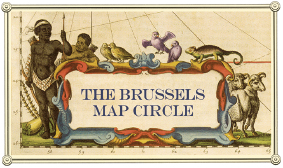De Zeven Zeeën
–Antwerp, Belgium
Organisation: Erfgoedbibliotheek Hendrik Conscience
In Antwerp, Abraham Ortelius invented a new type of book, the atlas. Henceforth travellers could map their route before their departure. Those who stayed at home could also let their eyes wander across remote regions, tracing distant coasts with their finger and dreaming about pristine areas that had yet to be discovered.
Above all, maritime atlases appeal to the imagination. The seemingly endless oceans were filled with ships and sea monsters, compasses and course lines form intriguing networks, and phantom islands appear and disappear again. Navigation books, maritime maps and atlases as well as the renowned globes by Blaeu are just some of the masterpieces used to develop the story of these heroic mariners.
In the Middle Ages, the main port cities of the Low Countries were part of the Hanseatic cities network, which stretched from the North Sea to the Baltic Sea, from Bruges to the Novgorod Republic. Sailors that travelled this route stayed close to the coast (coastal navigation) and used penned handbooks (pilot books or rutters). Starting in the sixteenth century, these were gradually replaced by portolan-like charts, which offered a visual representation of the coastline accompanied by written notes. One of the most spectacular examples is the unique Seabook in the Hendrik Conscience Heritage Library, a manuscript that consists of an illustrated description of the coastline from Heligoland to Lisbon.
One of the most influential maritime cartographers of all time was Lucas Janszoon Waghenaer from Enkhuizen. He had acquired considerable experience as chief officer on Dutch ships and knew exactly what sailors required. In 1584, he published his Spiegel der Zeevaart (Mariner's Mirror) with Christophe Plantin. It was the first printed mariner's guide in the world and the book remained the standard publication for centuries - the English term 'waggonner' is a bastardisation of the author's name.
One of the highlights of maritime cartography in the seventeenth century was the atlas Le Neptune François. It was compiled by scientists of the Académie Royale des Sciences (French Academy of Sciences) in Paris and was commissioned by Minister Colbert. The objective was to map the Atlantic coastline of the whole of Europe. The first edition was printed in Paris in 1693, and a few months later a pirate edition was published in Amsterdam by the renowned map publishing house Mortier.
The two stunning globes in the Nottebohm Room are masterpieces by Willem Janszoon Blaeu (c. 1571-1638), who was primarily known for his atlases. These globes, with a diameter of no less than 68 cm, are the largest he produced and with which he conquered the market. The two globes belong to the Heritage Library's collection and decorate the Nottebohm Room. They date from the period 1645-1648 and include additions by Johannes Blaeu, Willem’s son. The terrestrial globe features new discoveries in Australia, based on travel accounts by the Dutch explorer Abel Tasman. The celestial globe is also exceptional. The positions of the stars largely originate from the great Danish astronomer Tycho Brahe, to whom Blaeu was at one time apprenticed. These observations, of the highest possible quality at the time, were supplemented with 300 positions from southern constellations, measured by Frederick de Houtman.
The Nottebohm Room
The historical Nottebohm Room offers the ultimate decor for the exhibition 'The Seven Seas'. The Nottebohm Room is a hidden gem in the centre of Antwerp and is known as one of the most beautiful library rooms in Belgium. It is not only an exhibit space and a stack room, but is also the repository for a number of masterpieces from the collection.
E-mail: consciencebibliotheek@stad.antwerpen.be
